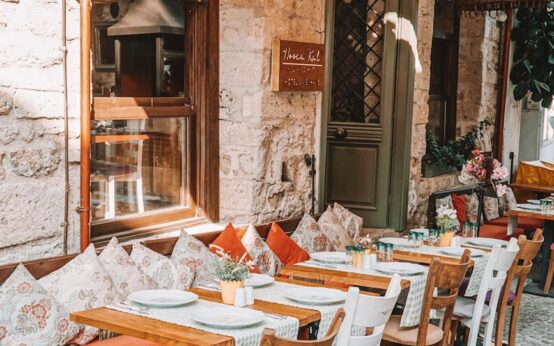Taste the Journey, Not Just the Destination
Picture this: you’re standing in a bustling airport, your flight is boarding in twenty minutes, and your stomach is rumbling. You grab a pre-packaged, vaguely sad-looking sandwich and a bag of chips. You devour it while speed-walking to your gate, scrolling through emails on your phone. Did you even taste it? Probably not. We’ve all been there. Travel, for all its wonders, can turn our eating habits into a chaotic mess of convenience over connection. But what if you could change that? What if every meal on your trip, from a quick airport snack to a multi-course dinner, could become a memorable part of the adventure itself? That’s the promise of practicing mindful eating while traveling, and it’s a game-changer.
It’s not about restriction or dieting. Far from it. It’s about amplification. It’s about turning down the noise of your hectic schedule and turning up the volume on your senses. It’s about truly tasting that fresh pasta in Rome, savoring the complex spices in a bowl of pho in Hanoi, and actually enjoying the moment. This isn’t just another thing to add to your travel to-do list; it’s a way to deepen your entire experience, making your memories richer and your body happier.

Key Takeaways
- Pause Before You Partake: Take three deep breaths before your first bite to ground yourself in the present moment.
- Engage All Five Senses: Look, smell, listen to, touch, and finally taste your food to create a full sensory experience.
- Ditch Digital Distractions: Put your phone away during meals to focus solely on your food and your surroundings.
- Listen to Your Body: Tune into your genuine hunger and fullness cues instead of eating out of boredom or because “it’s there.”
- Connect with Culture: Use food as a bridge to understand the local culture, history, and people.
- Embrace Imperfection: Don’t aim for perfect mindfulness at every meal. One mindful bite is a win.
Why is Mindful Eating So Tough on the Road?
Let’s be real for a second. The idea of eating slowly and intentionally sounds lovely in theory, but when you’re on vacation, it feels almost impossible. Why? Because you’re fighting against a perfect storm of challenges.
First, there’s the disruption of routine. At home, you have your regular meal times, your go-to snacks, your own kitchen. On the road, all of that is gone. You’re eating at odd hours to catch a train, grabbing whatever is available near a tourist site, and constantly adjusting to new time zones. Your body’s natural rhythm is completely out of whack.
Then comes the FOMO—the Fear of Missing Out. You’re in a new city with a famous culinary scene! You feel this immense pressure to try *everything*. The famous pastry, the legendary street taco, the local delicacy that everyone on Instagram is posting about. This can lead to eating not because you’re hungry, but because you’re afraid you’ll miss a quintessential experience. It becomes a checklist, not a meal.
And let’s not forget social situations. You’re often traveling with friends or family who have different eating speeds and preferences. It’s hard to be the one person saying, “Hey guys, can we all just pause and appreciate the aroma of this paella for a minute?” without feeling a little… weird. The pace is often set by the group, and that pace is usually fast.
Practical Strategies for a Mindful Eating While Traveling Experience
Okay, so we know it’s hard. But it’s not impossible. You don’t need to go on a silent meditation retreat to achieve this. You just need a few simple, practical tools in your travel toolkit. Think of these not as rules, but as invitations to connect more deeply with your food and your journey.
1. The Prep Work: Set Yourself Up for Success
Mindful eating on your trip begins before you even zip up your suitcase. A little bit of planning can make a world of difference.
- Pack Smart Snacks: Airport and train station food is often expensive and uninspiring. Pack some of your own go-to healthy snacks—nuts, protein bars, dried fruit. Having these on hand prevents you from making panicked, mindless choices when hunger strikes.
- Do a Little Food Recon: Spend 30 minutes researching the food scene of your destination. Look for local farmers’ markets, highly-rated restaurants away from the main tourist traps, or cafes known for a relaxed atmosphere. Having a few ideas in mind helps you be intentional rather than reactive.
- Set an Intention: On the plane, take a moment to set an intention for your trip’s meals. It could be as simple as, “I want to savor one meal a day without my phone,” or “I want to try new things and listen to my body’s response.”
2. Engage All Your Senses (The 5-Senses Check-In)
This is the heart of mindful eating. Before you take a bite, run through a quick sensory inventory. This pulls you out of your head and into the moment. It might feel silly at first, but it quickly becomes a powerful ritual.

- Sight: Really look at your food. Notice the colors, the textures, the shapes. Is it vibrant? Is it steaming? Appreciate the artistry on the plate.
- Smell: Bring the plate closer and inhale. What do you smell? Is it sweet, savory, spicy, earthy? Our sense of smell is powerfully linked to taste and memory.
- Sound: Listen. Is your food sizzling? Is the bread crusty? What are the sounds of the cafe or restaurant around you? Tune into the soundscape of your meal.
- Touch: Notice the temperature and texture of the food in your mouth. Is it creamy, crunchy, smooth, chewy? Pay attention to the weight of the fork in your hand.
- Taste: Finally, take your first bite. Chew slowly. Try to identify all the different flavors. Let them unfold on your tongue. Most of us rush through this part, but it’s where the magic happens.
3. The Power of the Pause
If you only do one thing, make it this. Before you pick up your fork, stop. Put your hands in your lap. Close your eyes if you feel comfortable. And take three slow, deep breaths. That’s it. This tiny action, taking no more than 15 seconds, acts as a circuit breaker. It interrupts the frantic, automatic pilot mode we so often eat in. It signals to your brain and body that something different is about to happen. You’re shifting from “doing” to “being.” It’s a moment to arrive at your meal before your food does.
“The pause is a simple yet profound act. It’s the space between the chaos of your travel day and the nourishment of your meal. It’s where mindfulness begins.”
If you need a little help getting centered, a short guided meditation can be an incredible tool. You can find tons of them online that are just a few minutes long—perfect for a pre-meal reset.
4. Ditch the Distractions (Especially That One)
You know which one I’m talking about. Your phone. It’s the single greatest enemy of mindful eating. We scroll and swallow, text and chew, completely oblivious to the food in front of us. When you’re distracted, you can’t listen to your body’s fullness signals, you don’t taste the nuances of the flavors, and you rob yourself of the experience.
Make a pact with yourself: no phones at the table. If you’re dining alone, this is especially important (and challenging!). Instead of scrolling through social media, use the time to people-watch, to gaze out the window, to simply be with your food. If you need to check a map or look something up, do it before the food arrives. Treat your mealtime as a protected, screen-free zone. It will radically change how you experience your food.
5. Connect with Culture Through Its Cuisine
Food is so much more than fuel; it’s a story. It’s the history, geography, and culture of a place served up on a plate. Shifting your mindset from “I need to eat” to “I get to experience this culture through its food” is a powerful form of mindfulness.

Get curious. Ask the waiter about the history of the dish. Visit a local market and talk to the vendors about their produce. Take a cooking class. When you understand the story behind the food—where the ingredients came from, how it was prepared, what it means to the local people—your appreciation for it skyrockets. You’re no longer just consuming calories; you’re participating in a tradition. This connection makes the entire experience richer and more meaningful.
6. Embrace Imperfection and Banish Guilt
This might be the most important tip of all. You’re on vacation! There will be meals that are rushed. There will be times you eat a greasy slice of pizza at midnight because it’s delicious and you’re having fun. That is perfectly okay. Mindfulness is not about perfection; it’s about awareness. The goal isn’t to be a mindful eating zen master at every single meal. The goal is to bring a little more intention and a little more pleasure to your eating experiences when you can.
If you have a meal where you eat mindlessly, don’t beat yourself up. Just notice it without judgment and move on. The next meal is a new opportunity. Banish the guilt. Food on vacation is meant to be enjoyed. Mindfulness enhances that enjoyment; it doesn’t take it away.
Conclusion
Integrating mindful eating into your travels isn’t about adding another stressful task to your itinerary. It’s about unlocking a deeper level of enjoyment and connection that’s already available to you at every meal. It’s about transforming a basic human need into a rich sensory adventure. By pausing, tuning into your senses, and getting curious about your food, you do more than just feed your body—you nourish your soul and create vivid, delicious memories that will last long after you’ve returned home. So on your next trip, don’t just see the world. Taste it, too.
FAQ
-
What if I’m traveling with a group that eats really fast?
-
This is a common challenge! You can’t control how others eat, but you can control your own pace. Try taking smaller bites, or consciously putting your fork down between bites. This naturally slows you down without making a big deal of it. You can also take the lead in initiating conversation, which naturally makes everyone at the table eat a bit more slowly. You don’t have to be the last one finished, just aim to be more present for the bites you do take.
-
Is it possible to be mindful with street food or quick meals?
-
Absolutely! Mindfulness isn’t about the type of food or the setting; it’s about your awareness. If you’re grabbing a taco from a street vendor, instead of walking and eating, find a nearby bench or spot to stand for just five minutes. Take a moment to appreciate the smell, the look, and the texture of the first bite. Even a few moments of focused attention can turn a hurried meal into a mindful experience.
-
I feel guilty for indulging on vacation. How can mindfulness help?
-
Mindfulness is the perfect antidote to food guilt. Guilt often comes from mindless overeating—eating past fullness or eating something you didn’t even really want. When you eat mindfully, you are fully present for the indulgence. You taste every single bite of that decadent chocolate cake. Because you are so tuned in, you are often satisfied with a smaller portion and feel a sense of deep pleasure rather than guilt. It helps you distinguish between true enjoyment and mindless consumption.



 Faroe Islands: Guide to its Untamed, Serene Beauty
Faroe Islands: Guide to its Untamed, Serene Beauty  Discover the Joy of an Early Morning Walk in the City
Discover the Joy of an Early Morning Walk in the City  Islamic Gardens: A Paradise of Calming Symmetry
Islamic Gardens: A Paradise of Calming Symmetry  Best Plein Air Painting Destinations | Artist’s Guide
Best Plein Air Painting Destinations | Artist’s Guide  World’s Most Beautiful Greenhouses: A Visitor’s Guide
World’s Most Beautiful Greenhouses: A Visitor’s Guide  Birdwatching for Travelers: A Calming Hobby on the Go
Birdwatching for Travelers: A Calming Hobby on the Go  AI and Blockchain: A Powerful Tech Synergy
AI and Blockchain: A Powerful Tech Synergy  Get a Job in Blockchain: Your 2024 Web3 Career Guide
Get a Job in Blockchain: Your 2024 Web3 Career Guide  Wallet Types Explained: Hot vs Cold & More (2024 Guide)
Wallet Types Explained: Hot vs Cold & More (2024 Guide)  How Venture Capital is Shaping the Crypto Industry
How Venture Capital is Shaping the Crypto Industry  Sentiment Analysis for Crypto: A Trader’s Ultimate Guide
Sentiment Analysis for Crypto: A Trader’s Ultimate Guide  NFTs: The New Key to Membership & Brand Loyalty | Guide
NFTs: The New Key to Membership & Brand Loyalty | Guide